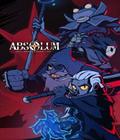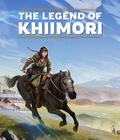Senran Kagura: Shinovi Versus is set in a world of ninja politics and drama. Hidden from the world are shin obi, elite ninja who perform tasks using special powers. There are shinobi who fight selflessly for the world and those who work as hired guns and assassins. Senran Kagura follows the story of multiple ninja schools dedicated to training the next in line to take over the various roles. Shinovi Versus follows three schools that are vying to become the top of the shinobi food chain: Gessen Academy, Hanzo Academy and Hebijo Academy.
In some ways, the plot feels at-odds with the brightly colored visuals. There are lots of monologues about the tragedy of violence and what it means to be good or evil, and they're followed by incongruous scenes like a wacky old man trying to grope someone. It holds together reasonably well, and the cast is varied, if somewhat archetypal. The translation work, as expected from XSEED, is genuinely good. The character dialogue is quite natural, and each character has a distinctive voice that makes it easy to figure out who's talking, even when the game doesn't specify.
The "fan service" element of the game is pretty uncomfortable. The English version omits character ages, but the cast is almost entirely composed of hyper-sexualized teenage girls. The first character I played as looked and acted like a child, complete with a giant teddy bear backpack. She fought with what appeared to be a plastic bucket of candy, and the plot involved her trying to figure out what it means to be a grown-up. This made it uncomfortable when the game wanted me to use the touch-screen to grope her and remove her clothes for a power-up. That's one of the more extreme examples, but it's the sort of atmosphere that pervades the entire product. Loading screen tips frequently remind me that I can use the dressing room to look at characters' panties or the Vita's microphone to blow up skirts. The rewards for winning are increasingly improbable variations on fetish costumes. There's even an in-game purchase mechanic that lets you buy new undergarments.
The real kicker is that all this stuff is completely unnecessary to the game. It doesn't add a single thing to the core gameplay, the story or any other element of the game. Even compared to something like Akiba's Trip, it feels blatantly unnecessary. Post-battle conversations occur with characters stripped down to their skivvies (or even less) without anyone acknowledging it. It's not just weird but frequently at odds with the dialogue and plot. It also interrupts the flow of combat, with the "clothing stripping" scenes getting in the way of combos — even if you skip them as quickly as possible.
That is more damning than it sounds because the other aspects of the game are actually pretty fun. The combat system isn't the deepest, but it's surprisingly well balanced. It's reminiscent of a simplified Dynasty Warriors title or an old-school beat-'em-up where you have swarms of disposable mooks and an elite enemy. You have a weak attack and a strong attack, and you can string them together to perform different combos. Certain attacks can launch an enemy into the air, and you can also use ninja energy to perform special techniques that do a ton of damage. You can easily cancel out of attacks, enabling you to string together much lengthier combos.
A major change from Dynasty Warriors is that killing generic enemies is not the focus of combat. Instead, the gameplay is built around ludicrously large combos. Rather than crowd-clearing attacks, each cast member has abilities that allow for long combo strings. Most boss fights tend to be back-and-forth variations on long combo strings until one side falls. Both players and enemies have the option to sacrifice 10% of their health to instantly break a combo string, and that's kind of a plus and minus. It's nice to prevent you from getting stun-locked, but it can also be annoying when a good combo is interrupted through no fault of your own.
Combos are made more complex by the Flash, Yang and Yin mechanics. By default, every character begins in a Flash state, which is usually a variation on a schoolgirl outfit. This is the default combat state, but it has no access to special moves and is the weakest of the sets. Once you have enough special attack energy, you can swap into either Yang or Yin mode. Yang is the shinobi form of the characters and is represented by a wacky outfit that can be customized. In shinobi form, characters gain new attack strings and access to special attacks, and they'll also receive a significant boost to their stats. They also regain all their health, but only once, so it's useful to save for use in a pinch. Yin is a Frenzy mode where the characters tear off their own clothes and fight in their lingerie. It's an attack buff — no pun intended — and they gain access to infinite combo strings and special techniques. There's also a tremendous debuff to defense. It's the best way to win fights if you're confident that you won't take damage, but it can be a huge drawback if you're not careful.
Both you and the enemy have access to these powered-up states, which can offer some extra flexibility to combat. Most enemies save their Yang state for when they're low on health, but that means you effectively have to fight them twice to win. If you use overwhelming force and special techniques properly, you can defeat them before they transform. This means you'll need to transform before they do, and screwing that up can put you at a disadvantage.
Since the game is so heavily focused on unbroken combos, each character's variety doesn't translate well to the fights. The game could do with more variety to prevent fights using the same character from feeling the same. You can swap to a new character once you get bored of an old one, but there should be more objectives and enemy variety.
There are lots of annoying breaks in the fights. There's a clothing damage mechanic, and if you damage a character enough, you'll see a cut scene that shows the clothing being damaged. Since this occurs during or after combos, it really can break the flow of fights. The same occurs with special moves, all of which display a lengthy cut scene before the attack. Games like Dynasty Warriors integrate their special attacks far more smoothly, and while the special attack scenes have nice animations, they lose their luster after the first few times. You can skip the cut scenes with a button press, but they still get in the way. An option to turn them off entirely would've been a great benefit.
If there's one problem with the combat, it's that the camera system is a bit of a mess. The camera is just not up to keeping track of fast-moving opponents in a small area, even with the assistance of in-game lock-on. It's fine in slower moments, but the second the action starts getting frantic, it falls apart. It looks at walls, clips into the floor, flails around wildly or points in the wrong direction. I had more than one fight that was stuck on a close-up of my character's leg or torso because I'd cornered an enemy and the camera couldn't figure out what to focus on. This isn't a tremendous problem when it comes to finishing stages, but it leads to frustration when you're trying to achieve good rankings. You can recenter it with the block button, but that doesn't help much during air combos or if the camera decides to not cooperate.
There's a fair bit of content in the game. There are multiple schools, each with their own story mode, and there are also special individual stories for most of the characters. A lot of this is repetitive, but it's a nice way to give each character the limelight, and there's a good scale to the difficulty that rewards tighter combos and more careful focus at higher levels. There are also a ridiculous number of unlockable costumes, accessories and various other widgets you can use to customize your characters or the game. Most of those are purely cosmetic, so they lack the RPG-style loot collection you see in other modern beat-'em-ups. If Shinovi Versus grabs you with its gameplay, you'll have a lot to do.
The visuals are relatively nice, and the characters are cleanly animated and distinctive. Some of the graphics look odd, but the combat animations are good. The environments were pretty unmemorable. Senran Kagura offers only the original Japanese voices with subtitles. It's an understandable limitation for a niche game, but it doesn't play well with the fast-paced gameplay. A lot of dialogue is presented as small, white text on the bottom of the screen, and that's kind of hard to focus on when you're trying to maintain a long air combo. It's good that all of it was subtitled, since much of the plot happens there, but this is one case where a dub would've benefited the game.
Senran Kagura is a difficult game to recommend because it often gets in its own way. If you're in it for the characters or the artwork, Senran Kagura amply provides. The title has some problems, including a particularly bad in-game camera, but the gameplay is solid. The overemphasis on fan service works against it, and fights are interrupted with tedious cut scenes. It's a shame because underneath that slathering of T&A is a pretty fun and well-designed beat-'em-up with a varied cast of characters.
Score: 7.0/10
More articles about Senran Kagura Shinovi Versus











 Senran Kagura Shinovi Versus is a battle action game where players take control of the girls from four different factions and battle it out to become the last shinobi squad standing.
Senran Kagura Shinovi Versus is a battle action game where players take control of the girls from four different factions and battle it out to become the last shinobi squad standing.













